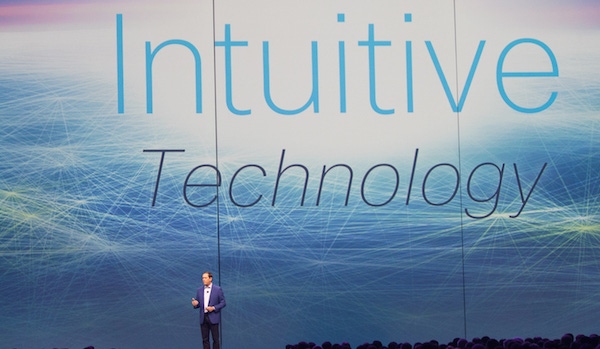Chuck Robbins opened Cisco's annual Partner Summit Wednesday by talking about geopolitics, "unbearable" amounts of data, and how the company is helping define the Era of Intelligence.

CEO Chuck Robbins opened Cisco’s annual Partner Summit, being held in Dallas, Texas this week, not by talking about new technologies, but about geopolitics. In order to adequately understand today’s threat landscape and the way networks have to evolve, Robbins said Cisco had to understand trade policy, job creation initiatives, tax structures, and the changing nature of the way people work around the globe.
These developments combined with the rapid rise of third-platform technologies like AI, machine learning, mobility, and cloud are changing the way end users consume IT, the way partners package and deliver IT solutions, and the way Cisco works to support its channel.
“We’re at a tech paradox where customers have never cared more about technology, and never cared less about deploying and implementing solutions,” said Robbins. “They just want the data and insights.”
Cisco calls it the Era of Intelligence, and it isn’t alone in building its future on customer data. The earnings results out of Amazon, Alphabet, and Microsoft last week show a clear lead for tech giants that have been collecting user data for years, and HPE CEO Meg Whitman told a group of 100 CEOs from 17 industries last week that legacy market leaders with troves of proprietary data will be virtually immune to disruption as the market adjusts to the digital transformation.
All that matters to Cisco is enabling customers to get insights from the “massive, unbearable amounts of data” they’re collecting, and that means giving its channel partners the tools to get their hands around all that information.
Cisco’s stated goals are to release solutions that are intuitive, simple, and secure. Customers are beginning to realize that the cloud is not a place that you move to, but a complex web of distributed assets across multiple clouds, SaaS applications, and the explosion of data at the edge.
Central to this new iteration of IT is the network, and Robbins says it’s the one common denominator that connects all of these emergent technologies and solutions. He outlined five key elements that define the intuitive Cisco network it’s counting on being the foundation for an always-connected world:
1. Security is foundational: Cyberdefenses aren’t something that can be tacked on anymore. Security has to be built upfront into an architecture that includes cloud, the network, end devices, data strategy, and so forth. Robbins said Cisco sees 20 billion threats every day, and their architecture is built to defend systems end-to-end.
2. Reinvent the network: According to IDC, in the next few years we’ll see a million devices added to the internet every hour. The network has to be fundamentally different than it is today in order to support that connectivity. Robbins told the audience Cisco has thousands of engineers working to rewrite core operating systems to build a network that’s simpler, programmable, scalable, and more agile. The goal is to apply advanced analytics to understand the business intent and use policy to apply that throughout the network. Chris Bernard of IDC says, “Cisco has fallen in love with networking again.”
3. Embrace the Multicloud World: Google Cloud CEO Diane Greene joined Robbins on stage to discuss the partnership announced last week to help customers build more efficient hybrid cloud solutions, which is focused on the Kubernetes container orchestration tool. The intent of the partnership is to bring the power and efficiency of the cloud into on-premise environments. Once again, engineers are leading this charge. “You know you have something going when the engineers are embracing and leading it,” said Robbins.
4. Unlock the Power of Data: Reiterating the morning’s running theme, Robbins says Cisco is building data analytics into the fabric of the network. Leveraging Cisco Talos for threat intelligence and AppDynamics for performance monitoring, the ability to manage data at the edge will enable end users, partners, and Cisco to win in a competitive marketplace.
5. Employee and Customer Experience: Robbins says that nearly 2/3 of us have deleted an app off of our mobile device after launching it just once because of our high user experience expectations and the multitude of alternative choices. Cisco emphasized that high-level customer experience is critical not only to winning over end customers, but those customers’ employees. Keeping tech talent happy will be critical as the skills gap widens, and partnering with collaboration providers such as BroadSoft—which Cisco announced last week it is hoping to acquire—will help partners increase their value throughout their clients’ business environment.
About the Author(s)
You May Also Like


